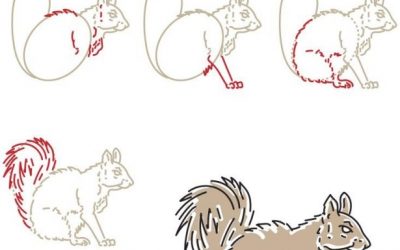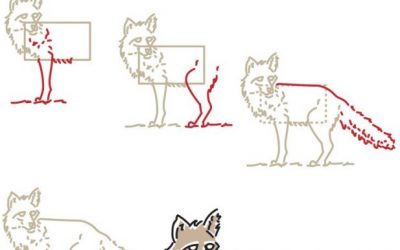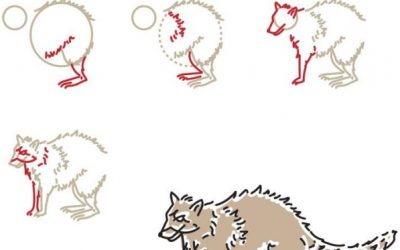
MATERIALS
• Arches Aquarelle 300gsm
• Fine brush, a 3/0 or a 2/0
• Windsor and Newton’s Artist’s watercolours in tubes: Titanium White, Permanent Rose, Sap Green, Scarlet Lake, Cadmium Yellow, Raw Umber, Black, Permanent Blue
STEP ONE
I start by selecting small specimens of native plants, usually from a friend’s bush block or my garden, or pick up leaves, fruits and twigs from walk trails near my home. Shells come straight from the beach, or from my vast collection. Bugs, beetles, moths etc. come from kind friends or my own collection.

STEP TWO
I then select the size of paper I want to use, tearing from a large piece of Arches Aquarelle 300gsm into smaller pieces using a blade and a metal straight edge. I never cut the paper or use scissors, as I believe the torn edge is more decorative and traditional.

STEP THREE
The first step in the painting process is to select the side of the specimen I want to depict, noting how the specimen lies naturally; top side of leaves, flowers etc. Photographs just don’t have that 3D effect and I rarely use them for illustration. Then I tape my ‘good’ paper to a small board on a table top easel and tape the specimen to a piece of copy paper on the left side.
Using a fine brush, a 3/0 or a 2/0, I do a faint outline in water colour of the main stem (if it is a plant) or the main body of the fruit or shell. This faint line is just to centre the image on the page and must be very faint and the same colour as the real thin, e.g. brown for a stem; green for a leaf.
I never ‘pencil in’ first, but when doing a composite picture i.e. a depiction of more than one plant, this outline helps with the overall design which is an important part of botanical illustration.
Depending on the specimen and the number of blossoms, I will either start on the left with the smaller foreground plants and systematically work my way over to the right, or, if there are a lot of flowers, I have learnt to paint all of them first and then join them up! Sometimes this method works, sometimes it is a bit hit and miss! A bit like joining the dots, but it saves on mixing of colours.
I used to always paint down and across, laboriously mixing green for a leaf, brown for the stem and another colour for the flower itself. This method was not only time consuming but led to inaccuracies in mixing and colour.
My sense of colour is wholly intuitive, with some technical aspects learnt along the way. I know nothing of the colour chart/wheel and complementary colours, despite having attended workshops to learn just that. I mix colours until I get the most accurate approximation of the real thing. I use a small square of Arches paper as a testing piece and mix on an old ceramic palette. Often the latter is very messy and recently cracked in half, so I am currently using two pieces.

STEP FOUR
I continue to layer colour until the satisfactory colours are achieved and usually I finish one part of the picture before going onto the next. I have to work as quickly as I can as the delicate flowers droop when out of water and wilt under the heat of the electric lamp I always work by. (Either an angle poise lamp or a daylight lamp). Pea flowers are particularly susceptible to this and curl over within minutes. A quick dip in water overnight usually refreshes them, but having a good memory and accurate botanical knowledge helps! Watercolour is not an easy medium at the best of times so using real specimens makes things difficult.
I don’t usually go back to a painting once I am satisfied I have finished. I find it hard to pick up the thread again and often the passion of that moment will have gone.

STEP FIVE
I put in shadows as I go. Some botanical artists don’t shade, but there are always shadows in nature e.g. a leaf over another leaf. Shadows are difficult to do, but they make the image look real and more lifelike. Likewise with leaves that have been eaten by bugs, or blemishes on leaves. I always include these if that’s how they are in nature. I tend not to ‘pretty’ things up. To shade, I mix Black with a small amount of Permanent Blue; starting off lightly as heavy shadows often overwhelm the specimen – being painted it is all a matter of practice to achieve the right result.
I try to leave as much white paper as possible, especially where white is the main part of the picture e.g. when painting ‘Southern Cross’. But on close inspection one can see pinks and yellows therein. When needing to highlight an edge against a darker background, I use Titanium White. I mostly use Windsor and Newton’s Artist’s watercolours in tubes, with about 10 or so old favourites e.g. Permanent Rose, Sap Green, Scarlet Lake, Cadmium Yellow, Raw Umber.
I source my brushes from the UK as they are difficult to find in this neck of the woods. These are handmade, reliable, competitively priced, and arrive within 10 days or so. I am still awaiting an order for small size brushes from Albany, my nearest big town, which I put in nearly a year ago!
STEP SIX
When I think that the painting is finished, I will leave it on my easel for a day or so, to check it with renewed vigour and a fresh eye. I can easily ‘over work’a painting, thus spoiling it, and then I have to remind myself that I don’t have to fill every white space. In Japanese painting the white spaces are just as important as the white bits. And although in nature all is rampant with few gaps, I must remember that not only am I capturing botanical accuracy, the aesthetic look is just as important.
To ‘marry’ accurate botanical illustration with a pretty picture i.e. good colour and design on the page, is the botanical artist’s ambition. Once I am satisfied that I have done my very best in this respect, I sign the bottom right hand corner of the page with a small PL and the year of painting. Sometimes I will pencil in the name of the plant at the bottom of the page, but only if I’m producing one species and only if I’m absolutely sure of the name! Too many mistakes have been made in respect of this.




FINAL STEP
The last step is to take a photo of the painting (as a whole), plus some detailed studies for my records and to write the number, name and size in my notebook.






